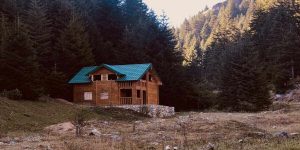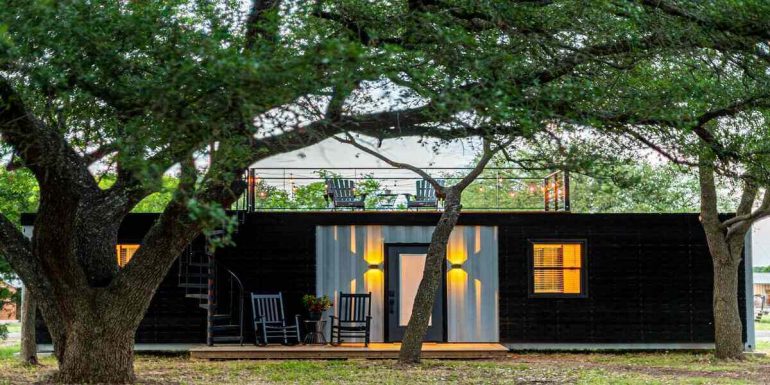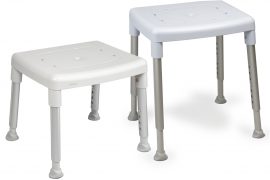The benefits of living in tiny homes are becoming increasingly popular and trendy in the United States, especially among millennials. These diminutive homes are anywhere from 100 to 400 square feet—much smaller relative to 2,600 square feet for a “normal” home.
Around 700 healthy homes build each year and an approximate total of 10,000 exist throughout the country. Their lack of space is appealing for minimalists who want to live frugally, off the grid, and without wasting any space.
However, the financial benefits of living in tiny homes are another primary reason for their popularity to increase. Tiny-home owners see significant savings in a variety of different areas, so read below to learn more.
Tiny Homes Cost Less to Build or Purchase

One of the largest reasons for the increasing popularity of tiny homes is the low cost to build or purchase. On average, a tiny home costs around $46,300 against $272,000 for a normal home.
A mortgage for a tiny home also averages about $150 per month, and a $7,500 down payment will likely get you a very low mortgage and interest rate. However, 68% of tiny home owners don’t even have a mortgage!
For a “normal” sized home, the average mortgage payment is around $1,000 and down payments have many different factors, such as the cost of the home and mortgage type. Either way, that down payment will be much more expensive than the downpayment of a tiny home.
Lower Bills and Expenses

The benefits of living in tiny homes also have significantly lower energy bills than other types of homes. As they consume much less energy than their normal-sized counterparts.
Less water usage and decreased waste amounts will lead to lower energy bills. Additionally, there will be fewer appliances in the home, so your electric bill will be significantly lower.
Due to their low square footage, it is very easy to heat and cool a tiny home. Most likely, you’ll only need one air conditioning unit to adequately heat the entire area.
Ductless mini splits are an excellent and affordable heating and cooling option for tiny homes. Traditional duct central HVAC systems are not feasible in tiny homes. As they require large amounts of space for the ductwork needed to disperse air throughout the home.
The ductwork also leads to large amounts of energy waste, which eliminates ductless mini splits. Mini splits are also available in single-zone systems, which consist of an outdoor compressor connected to an indoor air handling unit.
They operate at highly efficient levels, meaning they will adequately heat your entire mini home and lower your energy bill even more.
Easier to Save Money in a Tiny Home

It is much easier to save money while living in a tiny home. Many Americans live paycheck to paycheck, with half their income going toward living expenses such as rent and utilities.
Since overhead and the cost of living are so low in tiny homes, it is very easy for homeowners to save money. In fact, 55% of tiny-home owners have more money in the bank (~$11,000 in savings) than normal-home dwellers.
Tiny-home owners have the freedom to invest their money properly, which will only increase their long-term financial flexibility and positioning.
Freedom from Debt

Since tiny-home owners are saving money, they are also less likely to be in debt. Most people must take out loans to purchase or build a home, and high interest rates and mortgage payments are a crippling long-term financial burden for most.
The other benefits of living in tiny homes are the prices are very reasonable to build, purchase, or rent. Therefore, homeowners are less likely to go into debt during the purchase or construction process of a tiny home.
More Disposable Income

Since tiny-home owners are saving money in all of the aforementioned ways, they have more disposable income available if they choose to spend it.
With the diminished cost of living, tiny-home owners can simultaneously save money while seeing an increase in their disposable income.
Tiny-home owners will likely not spend their disposable income on possessions, as they do not have the space. Therefore, they can spend money on experiences instead.
They can afford to travel the world, eat out, or purchase front row tickets for their favorite band or team instead.
Less Furnishing and Materials

The other benefits of living in tiny homes also cost less to furnish than normal homes, like less space to fill means less furniture to purchase. Many tiny homes only contain necessities when it comes to furniture, such as a bed and storage devices.
Homeowners in large houses often find themselves purchasing furniture for the sole reason of filling a space. This does not happen in a tiny home, as each and every square foot is properly utilized!
People in tiny houses opt for a minimalist lifestyle, which means they are dissuaded from purchasing unnecessary material possessions.
Many in larger homes have impulse purchases lying around the house that are rarely used and serve little to no value. Tiny homes do not have excessive space for these items.
Lower Cleaning Costs and Less Clutter

Tiny homes also have lower cleaning costs than normal homes. Many homeowners have to spend large amounts of time and excessive amounts of money on cleaning products to maintain their homes. Some even opt to use cleaning services, which can be costly over the long term.
Tiny homes take very little time to clean, and there is limited storage space for excessive cleaning products. Since the space in tiny homes is used so effectively and homeowners are less likely to purchase unnecessary material possessions.
There is also much less clutter lying around. This means it is much easier to maintain your tiny home and keep it looking clean.
In conclusion, there are many financial benefits to living in a tiny home. With this variety of financial incentives, it is very easy to see why more and more are ditching their excessively large homes and apartments for a cozy tiny homes.




